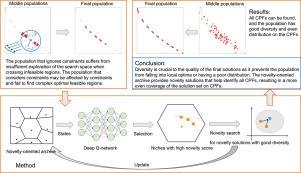针对受限多目标优化的沃罗诺伊区域深度强化学习辅助新奇搜索
IF 8.2
1区 计算机科学
Q1 COMPUTER SCIENCE, ARTIFICIAL INTELLIGENCE
引用次数: 0
摘要
解决约束多目标优化问题(CMOPs)需要优化多个相互冲突的目标,同时满足各种约束条件。现有的约束多目标进化算法(CMOEAs)通过忽略约束条件来跨越不可行区域。然而,这些方法可能会忽略有希望的搜索方向,导致对搜索空间的探索不足。为了解决这个问题,本文提出了一种深度强化学习辅助的约束多目标质量多样性算法。该算法设计了一种多样性维护机制,以促进最终解集在约束帕累托前沿的均匀覆盖。具体来说,首先,利用中心点 Voronoi 网格创建一个面向新颖性的档案,将搜索空间划分为所需数量的 Voronoi 区域。每个区域都作为具有不同表型特征的非主导解的存储库,以提供多样性信息和补充进化轨迹。其次,为了提高资源利用率,我们采用了深度 Q 网络来学习一种策略,根据新颖性得分选择合适的 Voronoi 区域生成子代。对这些区域的探索旨在找到一组多样化、高性能的解决方案,以加速收敛并摆脱局部最优状态。与八种最先进的 CMOEA 相比,对四种基准套件和九种实际应用的实验研究表明,所提出的算法表现出更优越或至少具有竞争力的性能,尤其是在可行区域离散且狭窄的问题上。本文章由计算机程序翻译,如有差异,请以英文原文为准。

Deep reinforcement learning assisted novelty search in Voronoi regions for constrained multi-objective optimization
Solving constrained multi-objective optimization problems (CMOPs) requires optimizing multiple conflicting objectives while satisfying various constraints. Existing constrained multi-objective evolutionary algorithms (CMOEAs) cross infeasible regions by ignoring constraints. However, these methods might neglect promising search directions, leading to insufficient exploration of the search space. To address this issue, this paper proposes a deep reinforcement learning assisted constrained multi-objective quality-diversity algorithm. The proposed algorithm designs a diversity maintenance mechanism to promote evenly coverage of the final solution set on the constrained Pareto front. Specifically, first, a novelty-oriented archive is created using a centroid Voronoi tessellation, which divides the search space into a desired number of Voronoi regions. Each region acts as a repository of non-dominated solutions with different phenotypic characteristics to provide diversity information and supplementary evolutionary trails. Secondly, to improve resource utilization, a deep Q-network is adopted to learn a policy to select suitable Voronoi regions for offspring generation based on their novelty scores. The exploration of these regions aims to find a set of diverse, high-performing solutions to accelerate convergence and escape local optima. Compared with eight state-of-the-art CMOEAs, experimental studies on four benchmark suites and nine real-world applications demonstrate that the proposed algorithm exhibits superior or at least competitive performance, especially on problems with discrete and narrow feasible regions.
求助全文
通过发布文献求助,成功后即可免费获取论文全文。
去求助
来源期刊

Swarm and Evolutionary Computation
COMPUTER SCIENCE, ARTIFICIAL INTELLIGENCEC-COMPUTER SCIENCE, THEORY & METHODS
CiteScore
16.00
自引率
12.00%
发文量
169
期刊介绍:
Swarm and Evolutionary Computation is a pioneering peer-reviewed journal focused on the latest research and advancements in nature-inspired intelligent computation using swarm and evolutionary algorithms. It covers theoretical, experimental, and practical aspects of these paradigms and their hybrids, promoting interdisciplinary research. The journal prioritizes the publication of high-quality, original articles that push the boundaries of evolutionary computation and swarm intelligence. Additionally, it welcomes survey papers on current topics and novel applications. Topics of interest include but are not limited to: Genetic Algorithms, and Genetic Programming, Evolution Strategies, and Evolutionary Programming, Differential Evolution, Artificial Immune Systems, Particle Swarms, Ant Colony, Bacterial Foraging, Artificial Bees, Fireflies Algorithm, Harmony Search, Artificial Life, Digital Organisms, Estimation of Distribution Algorithms, Stochastic Diffusion Search, Quantum Computing, Nano Computing, Membrane Computing, Human-centric Computing, Hybridization of Algorithms, Memetic Computing, Autonomic Computing, Self-organizing systems, Combinatorial, Discrete, Binary, Constrained, Multi-objective, Multi-modal, Dynamic, and Large-scale Optimization.
 求助内容:
求助内容: 应助结果提醒方式:
应助结果提醒方式:


